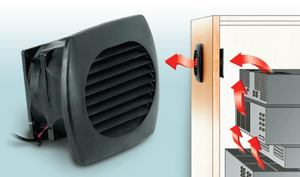Stephen Cole, electronics system designer at The Sound Room in Chesterfield, Mo., is giving a tour of a sauna-size utility closet in an upscale installation outside of St. Louis. But there’s nothing steamy about this temperature-controlled space. “When the house was being built, the other contractors kept coming in here to cool off,” Cole says. “The heat was stifling in the rest of the house but we keep this room at a constant 60 degrees.”
Electronics need air conditioning, too, Cole explains, and as more homes come outfitted with high-power home theaters, multi-room audio, automatic lighting, and networking gear—along with the components required to control these systems—keeping electronics cool will become a vital part of making sure the tech home continues to operate at optimum performance.
In this installation, the home theater’s amplifiers alone rack up more than 6,000 watts of power, a good portion of which winds up as heat due to an amplifier’s inherently inefficient design. That heat can warm up a small space fast, so it’s the job of installers like Cole to keep a cool head. Working with the HVAC contractor, Cole designed a raised-floor ventilation system with HVAC vents under each rack of electronics. The room’s dedicated furnace remains at 60 degrees at all times and the cold-air return from the furnace creates a chimney effect that prevents the tall stacks of gear from overheating.
Providing climate control for electronics serves the interests of the homeowner and the installer. Heat is the enemy of microprocessor-controlled electronics, and with microprocessors at the heart of everything from microwave ovens to home control systems these days, keeping those delicate brains calm is the key to error-free operation.
“Overheating,” Cole says, “can lead to very annoying results.” He knows from experience, having dealt with finicky satellite receivers, for instance, that act out when they overheat in tight spaces. Malfunctions include glitches such as having picture but no sound or not being able to switch channels. Maybe the picture locks up altogether.
In worst-case scenarios, circuit boards and resistors can go bad as a result of warm operating conditions and must be replaced. “Whenever possible we put equipment in a self-contained room with great airflow,” Cole says, “That way there’s not as much wear and tear on the gear.”
Middle Atlantic Products and Active Thermal Management (ATM) are two companies that have developed products to address residential thermal management. “Homeowners are demanding increasingly sophisticated systems,” says Mark Tracy, vice president of marketing and business development for Middle Atlantic Products. “Because they’re digital and computer-driven, they have increased processing power packed into smaller spaces, which means increased thermal density.” As a result, he says, digital components are more susceptible to failure, whether intermittent or long term. For every 10-degree rise over 85 degrees, the digital equipment life expectancy is reduced by 40 percent, Tracy says.
That can lead to strange behavior. “Digital equipment does funny stuff and it could be because it’s too hot,” says Tracy of Middle Atlantic. “Say the satellite receiver cooks, and then it gives it up or shuts down. The owner is upset, calls whomever, they come out for a service call and by then the receiver has cooled down and everything is fine. It’s like taking the car to the mechanic. Those thermal issues are hard to put your finger on.”
The heat can shorten the life of the electronics. “This equipment is designed to operate on a cabinet at waist height in a 70-degree room with no restriction on ventilation,” says Federman of ATM. “Once you start putting them next to gear that’s hot and putting them in a cabinet, things change. Stuff made today is so reliable you could easily expect to get 10 to 15 years out it, but that’s operating with unrestricted ventilation at 72 degrees. What could have lasted 10 years is going to last 18 months under extreme conditions.”



